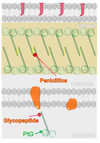Antibiotics and Anti-fungals Flashcards
Describe the distinctive features of: a. Gram positive bacteria b. Gram negative bacteria c. Mycolic bacteria
a. Gram positive bacteria
- Thick peptidoglycan cell wall
- E.g. Staphylococcus Aureus
b. Gram negative bacteria
- Outer membrane that contains lipopolysaccharide (LPS)
- E.g. Escherichia Coli
c. Mycolic bacteria
- Same as gram positive
- but with an additional outer mycolic acid layer
- E.g. Mycobacterium Tuberculosis

State the steps involved in the production of THF from PABA.
PABA –> DHOp (enzyme = dihydropterase synthase) DHOp –> DHF DHF –> THF (enzyme = DHF reductase)

What is DNA gyrase?
A type of topoisomerase (topoisomerase II) It releases tension in DNA and is important in unwinding DNA to allow protein binding required for DNA replication
What does RNA polymerase do?
Produces RNA from a DNA template
What is the key difference between ribosomes in eukaryotes and prokaryotes?
Eukaryote: 40S + 60S = 80s Prokaryote: 30S + 50S = 70s
State two classes of drugs that interfere with nucleic acid synthesis and name the enzymes that they inhibit.
- Sulphonamides – inhibits dihydropterate synthase
- Trimethoprim – inhibits DHF reductase

What is the name of the preparation containing the 2 drugs that interfere with nucleic acid synthesis?
Co-trimoxazole
Name a group of drugs that interfere with DNA replication and state its targets.
Fluoroquinolones (e.g. ciprofloxacin) Inhibits bacterial DNA gyrase and topoisomerase IV
Name a group of drugs that interfere with RNA synthesis and state its main target.
Rifamycins (e.g. rifampicin) Inhibits RNA polymerase
List 4 groups of drugs that interfere with ribosomes.
Macrolides e.g. Erythromycin Chloramphenicol Aminoglycosides e.g. Gentamicin Tetracyclines
Describe how peptidoglycan is synthesized, transported to the cell wall and incorporated into the cell wall.
In the cytoplasm:
- A pentapeptide is created on N-acetyl muramic acid (NAM)
- N-acetyl glucosamine (NAG) associates with NAM forming peptidoglycan
- Peptidoglycan is then transported across the cell membrane into the periplasm by bactoprenol
- The peptidoglycan is then incorporated into the cell wall by transpeptidase enzyme, which cross-links the peptidoglycan pentapeptides

Which groups of drugs interfere with peptidoglycan synthesis and how do they do this?
- Glycopeptides (e.g. vancomycin)
- They bind to the pentapeptides and inhibit peptidoglycan synthesis
- This is used as a last resort for Gram-positive bacteria that are resistant to other antibiotics

Name a drug that interferes with peptidoglycan transport and state its target.
Bacitracin – this inhibits bactoprenol, hence preventing peptidoglycan transport

Name a class of drugs that inhibit peptidoglycan incorporation and explain how they do this.
Beta lactams – they bind covalently to transpeptidase, which inhibits peptidoglycan incorporation into the cell wall

What are the three subsets of beta lactams?
Carbapenems Cephalosporins Penicillins
Name two drugs that interfere with cell membrane stability and explain how they do this.
- Lipopeptides – disrupt Gram-positive cell membranes
- Polymyxins – bind to lipopolysaccharide and disrupt Gram-negative cell membranes

List five mechanisms of antibiotic resistance and give a brief description of each.
Additional target– the bacteria produce another target that is unaffected by the drug e.g. different DHF reductase enzyme Hyperproduction – the bacteria increase the production of the target so the antibiotics are less effective (this is energy inefficient) e.g. over-prodution of DHF reductase Altered target site – there is an alteration in the drug target so that the drug is no longer effective e.g. mutations in DNA gyrase Alteration in drug permeation– down regulation of aquaporins (responsible for allowing drugs into cells) or the upregulation of efflux systems Production of destruction enzymes– beta-lactamases hydrolyse the C-N bond in the beta-lactam ring rendering the beta-lactams inactive
What are the four types of fungal infection, characterised based on the tissues/organs affected?
Superficial – outermost layers of skin Dermatophyte – skin, hair or nails Subcutaneous – innermost skin layers Systemic – primarily respiratory tract
What are the two main groups of anti-fungals? Give an example of each.
Azoles (fluconazole) Polyenes (amphotericin)
Describe the mechanism of action of azoles.
They inhibit a CYP450 dependent enzyme which is involved in ergosterol production (a membrane sterol of fungi)

Describe the mechanism of action of polyenes.
These interact with ergosterol (a membrane sterol) and form channels (punching holes in the membrane)
What is important for prokaryotic DNA synthesis?
Tetrahydrofolate (THF) Produced in a synthesis pathway starting with Dihydropteroate (DHOp)


